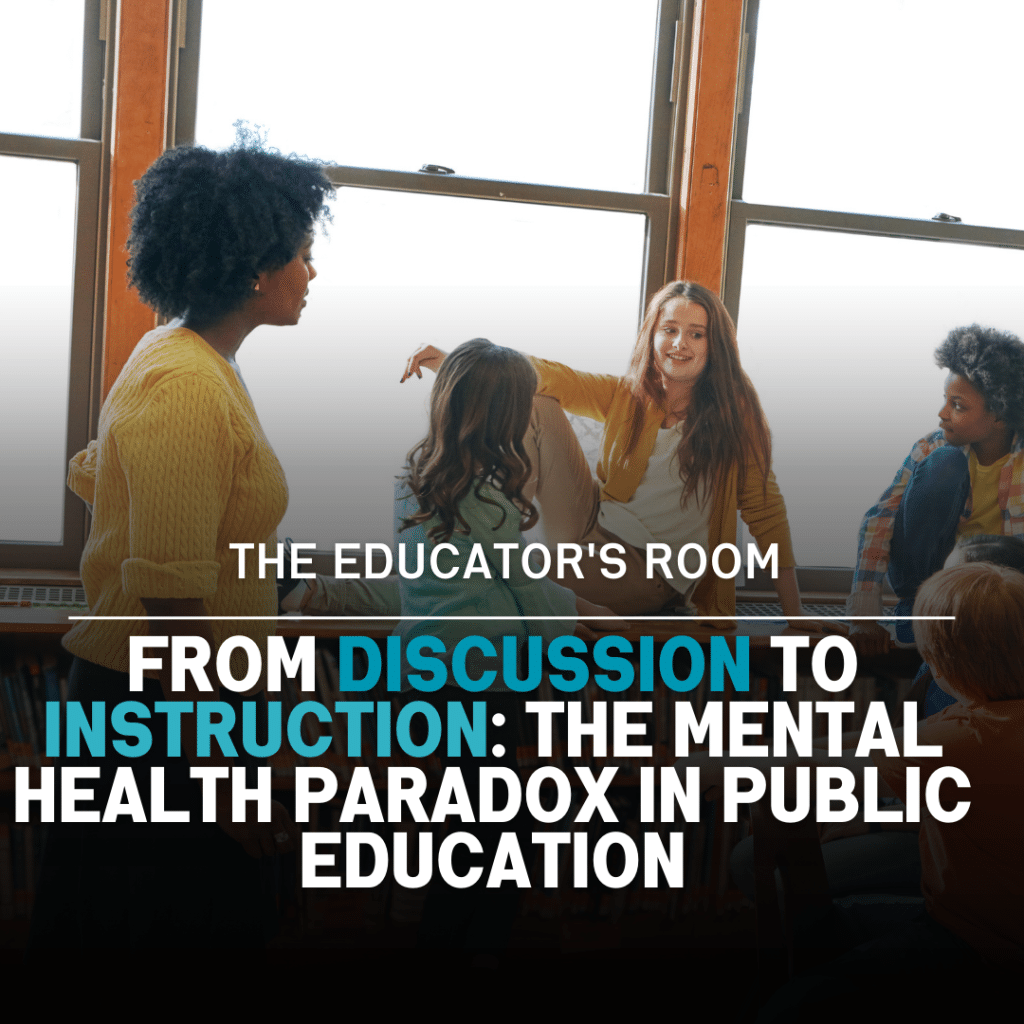By Jessica Lyons
There seems to be a paradox in public education regarding helping students cope with mental health issues. On the one hand, the federal government is pushing to fund more resources for mental health services. In the past few months, the federal government allocated $188 million to increase access to school-based mental health services with funding provided by the Bipartisan Safer Communities Act (BSCA) and another “$25 million to expand primary health care, including mental health services”, in schools was rationed as well. Yet, on the other hand, states are passing versions of “The Parental Rights in Education Act,” forcing more and more educators to fear open conversations in the classroom and with their students- pushing the topic of mental health into darker corners of the taboo turf.
If a teacher is scared to talk about anything that might be considered taboo and cause them to lose their job, how should that teacher have meaningful conversations with her students? How can that teacher cultivate a classroom culture of acceptance and inclusion, especially when discussing mental health topics?
I start my classes every year by asking my students for a writing sample. There is no topic; they can write about WHATEVER they want. As a new(er) teacher, I had a student write a long letter to me. Essentially the student came out and was petrified to tell her parents. Not to mention the fear and anguish she felt. This letter was one of the most powerful moments I have ever had in teaching. To be entrusted with such a burden, there cannot be a higher compliment. After class, I spoke with the student and had a long, tear-filled by both conversations. I convinced her to talk with a guidance counselor, one that I deeply trusted, and thankfully the student could speak with her parents, and they lovingly accepted her.
Happy ending, but would I have felt comfortable having the conversation today? Most PREA bills read something like, “Classroom instruction … on sexual orientation or gender identity may not occur …in a manner that is not appropriate or developmentally appropriate for students.”
But here’s the rub, where is the line between instruction and discussion? In my classroom, nearly all instruction is fostered through discussion.
So that discussion is wonderful as long as I don’t cross that line from “discussion to instruction,” right?
Mental health has always been important to me. But it wasn’t until about five years ago that I realized how much I NEEDED to pay more attention to it, especially my own. I quickly realized how much depression and anxiety were taking a toll on my personal and professional life.
Don’t get me wrong; there were always days in my teaching when I would rather lay around and not get out of bed or snap at my students for no good reason. But I always chalked it up to “typical teacher stress” or tiredness.
It wasn’t until I started experiencing physical symptoms, like chest pains and trouble sleeping, that I finally decided to take a closer look at what was happening. And I’m so thankful I did because my therapist sent me straight to the ER. After a series of cardiac tests, my Dr. and therapist told me things could get serious if I didn’t take better care of myself. Actually, what my therapist said was, “you better quit that f#%@ing teaching job, or it is literally going to kill you.
I didn’t quit, but I did make some drastic decisions. And I have been proud of those changes in my classroom. One of the most profound changes I made was becoming comfortable talking to my high school students (juniors and seniors) about mental health. My room has become a culture of respect and sharing. Modeling is a cornerstone of teaching, right? So I model that mental health is not a taboo subject.
After the terrifying ER incident, I was eventually diagnosed with high-functioning anxiety with periods of infrequent depression. So over the past five years, I have taken steps to treat my mental health issues, including medication, therapy, and practicing self-care. It has been a long journey, and frankly, as a teacher, it will not end until I retire, but I am in a much better place than I have ever been before in my entire 45 years of life.
And as I have moved through this process, I have been bugged by why mental health is often considered taboo. People simply do not discuss it. AND especially in class. But why? And now, as governments put more restrictions on what can be discussed, shouldn’t there be a discussion about how the restrictions go against the foundations educators have strived to create that safe space? For example, the Association of School Climate, Depression Literacy, and Mental Health Stigma Among High School Students noted that the safe space “has a profound effect on students’ attitudes toward learning, including whether students like school, enjoy class, and their intrinsic academic motivation.”
And Timothy C. Clapper writes, “However, one can have the greatest number of learning strategies on their tool belt and be willing to engage each of their learner’s… but if the learning environment is not safe, learners may not fully engage with these activities.”
So I embraced this creation of a safe space, but now I question whether I can still do that…and keep my job.
I can create those safe spaces as long as I don’t cross that line from “discussion to instruction,” right?
Every class, I start with a bell ringer with a place on a Google form to ask me any questions. I get THE BEST QUESTIONS: “Do you know the muffin man?” “What is your opinion on pineapple on a pizza?” “Why do we even have school?” One day a student asked, “Do you have any strategies for panic attacks?” I typically just read the questions out loud and answer them, but I asked the student if this was a class question or a “talk to me at the end of class” question.” The student openly said, class question. And the floodgates opened! And not from my side.
So I shared. I shared that I like the 5 4 3 2 1 anxiety trick. A different student asked me to explain what that meant, so I did. The class continued, but the Bell Ringer questions kept becoming more frequent from other students, “Do you have panic attacks?” “How do you know if you are depressed or just sad?” Yes, I had the counselor in the loop ANY time there was a concern. However, I was honest and told them my experiences. I always said ALL emotions are personal, like a poem (sorry couldn’t resist). So they needed to take everything I said with a grain of salt (no….they had no idea what that meant).
The bell ringer is a fabulous practice as long as I don’t cross that line from “discussion to instruction,” right?
Sharing my experiences with my students has been a cathartic and empowering experience for me as a teacher. And I have never thought about changing those conversations until recently. My classroom is not a therapy session; I share stories. The majority of my teaching is storytelling, so this fits. I share how in high school, I would have panic attacks before tests- even though I didn’t know at the time that was what they were. I share how thoughts sometimes race through my mind at night, and I can’t sleep. The National Journal of Medicine reported that “teachers who share their mental health struggles with their students can help reduce stigma and increase understanding of mental health issues”.
And that is all excellent as long as I don’t cross that line from “discussion to instruction,” right?
I know that if I lose that feeling of open discussion, I will lose my identity as an educator. The benefits I have seen in my classroom have blown me away. There is much more discussion and open ideas shared during class lessons. Students have told me they aren’t scared to express their opinion in my class because they know they will be heard. We as educators already know what the US Department of Education states, “When students feel safe, they are better able to focus on learning, which in turn leads to increased academic achievement.”
So these stories are awesome as long as I don’t cross that line from “discussion to instruction,” right?
The research is staggering about the correlations between students feeling safe- social and emotional health- and academic success. And the research is growing in support of breaking the taboo. It creates a supportive environment for students, reducing stigma and increasing understanding of mental health issues. But I really didn’t need the research to tell me that; I could see it in my room.
I know that educators put every bit of their heart into their craft. And I am not advocating for teachers to spill their deepest anxiety and angst with their students. But speaking from the research and personal experience, the more you let your kids in, the more they let you in. Additionally, teachers who disclose their struggles can serve as positive role models for students, demonstrating that they can succeed despite mental health challenges.
And that is all great as long as you don’t cross that line from “discussion to instruction,” right?








Thank you for this article. I don’t think I have had a year, in the past ten years at least, in which a student did NOT confide and come out in that first essay of the school year. We seem to have moved from “honoring a student’s rights to confidentiality” to being told we are not permitted to do so. Protecting students and honoring confidentiality is a hill I will die on in this profession if it comes to that.